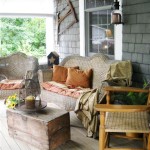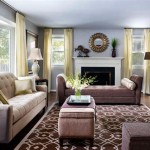Embracing Colorful Modern Home Decor: A Guide to Infusing Vibrancy into Contemporary Spaces
Modern home decor often emphasizes clean lines, minimalist aesthetics, and neutral color palettes. However, incorporating vibrant hues into modern designs can create a dynamic and inviting living space. Colorful modern home decor is not about overwhelming the senses with excessive brightness; it's about strategically using color to enhance the existing architectural features and create a personalized atmosphere. This approach requires careful planning and a nuanced understanding of color theory to achieve a harmonious balance between modern simplicity and colorful expression.
The integration of color into modern design is rooted in the principle of enhancing, not overshadowing, the core elements of the space. The architectural design, furniture silhouettes, and textural choices should serve as a foundation upon which color is applied. The judicious selection of colors and their strategic placement can elevate the aesthetic appeal of a modern home, transforming it from a minimalist haven to a vibrant and engaging environment.
Understanding the Principles of Color Harmony in Modern Design
Color harmony is essential for achieving a balanced and visually appealing space. In the context of modern design, it's crucial to avoid overwhelming the clean lines and minimalist forms that define the style. Instead, color should be used to complement and accentuate these features. Several color schemes can be effectively implemented in modern homes, each offering a different aesthetic and impact.
The monochromatic color scheme involves using variations of a single color. This scheme can create a sophisticated and calming atmosphere, particularly when using muted or pastel shades. For example, a room could feature walls in a light gray-blue, complemented by furniture in varying shades of deeper blue and textured accessories in a similar tone. This approach provides visual interest while maintaining a sense of cohesion and tranquility.
The complementary color scheme utilizes colors that are opposite each other on the color wheel, such as blue and orange, or red and green. This scheme creates a vibrant and dynamic contrast, which can be particularly effective in spaces where energy and stimulation are desired. However, it is crucial to use these colors in moderation to avoid overwhelming the space. A common technique involves using one color as the dominant hue and the other as an accent.
The analogous color scheme involves using colors that are adjacent to each other on the color wheel, such as blue, blue-green, and green. This scheme creates a harmonious and soothing effect, as the colors blend seamlessly together. Analogous color schemes are often used in bedrooms or living rooms to promote relaxation and tranquility. For instance, a room could feature walls in a soft green, complemented by furniture in shades of blue-green and accessories in varying tones of blue.
The triadic color scheme utilizes three colors that are evenly spaced on the color wheel, such as red, yellow, and blue. This scheme creates a balanced and playful effect, which can be particularly effective in children's rooms or creative spaces. However, it's crucial to use these colors in moderation to avoid overwhelming the space. A common technique involves using one color as the dominant hue and the other two as accents scattered throughout the room.
Achieving a balanced color palette also involves considering the interplay between warm and cool colors. Warm colors, such as red, orange, and yellow, tend to evoke feelings of energy and excitement. Cool colors, such as blue, green, and purple, tend to evoke feelings of calmness and serenity. By combining warm and cool colors in a balanced manner, it's possible to create a space that is both stimulating and relaxing.
Strategic Application of Color in Different Areas of the Home
The strategic application of color is crucial for creating a cohesive and visually appealing space. The specific colors and their placement should be carefully considered based on the function of the room and the desired atmosphere. Different areas of the home can benefit from different color palettes and design approaches.
In the living room, color can be used to create a focal point. A brightly colored sofa, a vibrant piece of art, or a boldly painted accent wall can draw the eye and add visual interest to the space. Neutral walls provide a blank canvas for these colorful elements to stand out. Consider using a complementary color scheme to create a dynamic contrast or an analogous color scheme to create a calming and harmonious atmosphere. The selection of textures, such as plush rugs, velvet cushions, and woven throws, can also contribute to the overall aesthetic and enhance the impact of the chosen color palette.
In the bedroom, color can be used to create a relaxing and restful atmosphere. Soft, muted tones of blue, green, or lavender are often preferred for their calming properties. These colors can be used on the walls, bedding, and window treatments to create a sense of tranquility. Avoid using bright or intense colors, as they can be stimulating and disruptive to sleep. Layering textures, such as soft blankets, fluffy pillows, and textured wallpaper, can add depth and visual interest to the space without overwhelming the senses.
In the kitchen, color can be used to create a cheerful and inviting atmosphere. Bright, vibrant colors, such as yellow, orange, or red, can add energy and excitement to the space. These colors can be used on the walls, cabinets, or accessories to create a focal point. Consider using a complementary color scheme to create a dynamic contrast or a monochromatic color scheme to create a sophisticated and cohesive look. Stainless steel appliances and sleek countertops can provide a modern backdrop for these colorful elements to shine. Incorporating natural elements, such as wooden cutting boards, potted plants, and fresh herbs, can add warmth and texture to the space.
In the bathroom, color can be used to create a spa-like atmosphere. Soft, muted tones of blue, green, or gray are often preferred for their calming and refreshing properties. These colors can be used on the walls, tiles, and accessories to create a sense of tranquility. Avoid using dark or intense colors, as they can make the space feel cramped and claustrophobic. Incorporating natural elements, such as stone countertops, bamboo accents, and potted plants, can add warmth and texture to the space.
In hallways and entryways, color can be used to create a welcoming and inviting atmosphere. These spaces are often overlooked, but they provide an opportunity to make a strong first impression. Bright, cheerful colors, such as yellow, orange, or red, can add energy and excitement to the space. Consider using a complementary color scheme to create a dynamic contrast or a monochromatic color scheme to create a sophisticated and cohesive look. Adding a bold piece of art or a colorful rug can draw the eye and add visual interest to the space.
Integrating Colorful Accessories and Furniture into Modern Spaces
Accessories and furniture provide opportunities to introduce pops of color into a modern home without making drastic changes to the overall aesthetic. The strategic selection and placement of these elements can transform a neutral space into a vibrant and engaging environment. The key is to choose pieces that complement the existing design and add visual interest without overwhelming the senses.
Colorful throw pillows are an easy and affordable way to add a splash of color to a living room or bedroom. Choose pillows in a variety of colors, patterns, and textures to create a visually appealing ensemble. Mix and match different sizes and shapes to add depth and dimension to the space. Consider using pillows in complementary colors to create a dynamic contrast or pillows in analogous colors to create a calming and harmonious effect.
Area rugs are another effective way to add color and texture to a room. Choose a rug in a bold color or pattern to anchor the space and create a focal point. Consider using a rug in a complementary color to your walls or furniture to create a dynamic contrast. Rugs can also be used to define different zones within a larger space, such as a living room or dining room. Area rugs can also add a warm, cozy, and comfortable feeling to your space.
Artwork is a powerful way to express your personality and add color to your home. Choose pieces that reflect your personal style and complement the existing design. Consider using a gallery wall to create a visual statement or hang a large, colorful painting above the sofa. Artwork can also be used to tie together different elements of the room, such as the walls, furniture, and accessories.
Lamps and lighting fixtures can also be used to add color and style to a room. Choose lamps with colorful shades or bases to add a pop of color to a side table or desk. Consider using colored light bulbs to create a warm and inviting atmosphere. Lighting fixtures can also serve as a focal point in a room, especially when the design is unique.
Plants and flowers can add life and color to any space. Choose plants with colorful foliage or flowers to brighten up a room. Consider using a variety of plants in different sizes and shapes to add visual interest. Plants can also help to purify the air and create a more relaxing and inviting atmosphere. You could decorate your space by setting up flower pots, hanging planters, or a small indoor garden.
When selecting colorful accessories and furniture, it's important to consider the overall balance and harmony of the space. Avoid overwhelming the senses with too much color or pattern. Instead, focus on creating a cohesive and visually appealing design that reflects your personal style and enhances the overall aesthetic of your home. Small details, such as picture frames, vases, and decorative bowls, can also contribute to the overall design and create a cohesive style.

27 Colorful Home Design Decorating Ideas Extra Space Storage

27 Colorful Home Design Decorating Ideas Extra Space Storage

Modern And Colorful Interior Design
35 Colourful Living Room Ideas And Modern Designs Renoguide N Renovation Inspiration

12 Best Quirky Homeware And Home Décor Whole Brands

Colorful Home Decor In Sweden

A Modern Makeover With Method Emily Henderson Colourful Living Room Designs Natural Home Decor

Modern Can Be Colorful As Seen In This D C Home

This La Home Shows How To Do Modern Eclectic Style Perfectly With A Utility Room Of Dreams Living Colors Colourful Decor

50 Popular Living Room Colors Paint Ideas
Related Posts







